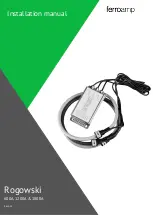
Pag. 18
SIRIO 2000T
SIRIO 2000T
SIRIO 2000T
SIRIO 2000T
SIRIO 2000T
Electronic Broadcast Equipment
5.2 PLACING THE TRANSMITTER
Install transmitter in a dry, sheltered but well-ventilated room free from dust, moisture, insects and vermin
(mice). Place transmitter as close as possible to the antenna to prevent excessive power loss in the antenna
cables. If this is not feasible, use lower loss antenna cables and electrical wiring of suitable cross-section.
Room size shall be such that the transmitter can be placed in an upright position and that technical
personnel can easily carry out both routine or extraordinary maintenance. The minimum recommended size
is 2.5m x 2m, and 2.2m high when there is no other broadcasting or support equipment nearby.
Operating temperature must be kept 10 ÷ +35 °C. Higher temperatures up to +45 °C, although
allowed, are not recommended since they will cause more stress and reduce the transmitter lifetime.
Thermal conditions cannot generally be met when the exhaust cooling air is not ducted outside but stays
into the room. This is even truer if more than one transmitter is installed in the same location. An efficient
ventilation system is thus required in the room. Air exchange in the room shall have a minimum flow-rate
of 500 metres cubed per hour, or more.
If the transmitter is fitted in a rack system, the back door of the rack cannot usually be fixed in place.
When a completely closed assembly is needed, a suitable ventilation extraction unit must be used. To aid
air ducting in such cases, an optional flange may be retrofitted on the ventilation outlet to which a duct can
be attached to convey hot air outside. Remember that SIRIO2000T internal fans are low-pressure units
and some sort of external air extraction blower is than imperative on the exhaust air duct.
Vents in the walls and any other openings shall be fitted with a metal grating to keep rodents out, and
with a dust filter. Make absolutely certain that no water can pass through the vents or the air exhaust duct
or antenna-cable grommet, and that the floor cannot be flooded during heavy rainfall. If not prevented by
a proper air filtering, insects may be conveyed in the internal heatsink, there accumulating on it and finally
obstructing it, causing overtemperature alarm.
Even moisture and/or dust, when contained in the air or in the room in excessive quantity, may cause
condensation to build-up in the amplifier. When the system is periodically switched on and off, this might
trigger some destructive electric arcs and short circuits causing a damage that is not covered by the
guarantee.
















































